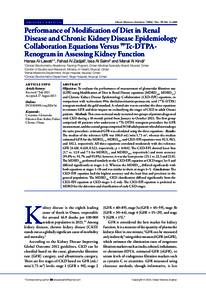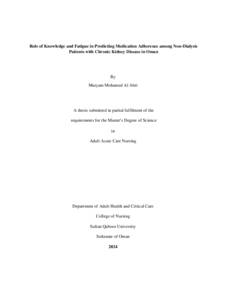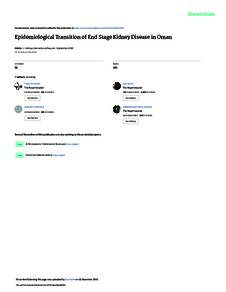Document
Performance of modification of diet in renal disease and chronic kidney disease epidemiology collaboration equations versus 99Tc-DTPA renogram in assessing kidney function.
Identifier
DOI 10.5001/omj.2024.54
Source
Oman Medical Journal, v. 39, no. 2, e606 p. [1-7].
Contributors
Country
Oman
City
Muscat
Publisher
Oman Medical Specialty Board.
Gregorian
2024-03-01
Language
English
English abstract
Objectives: To evaluate the performance of measurement of glomerular filtration rate
(GFR) using Modification of Diet in Renal Disease equations (MDRD186, MDRD175)
and Chronic Kidney Disease Epidemiology Collaboration (CKD-EPI) equations, in
comparison with technetium-99m diethylenetriaminepentaacetic acid (99Tc-DTPA)
renogram method, the gold standard. A related aim was to correlate the three equations
to estimate GFR and their impact on reclassifying the stages of CKD in adult Omani
patients. Methods: This cross-sectional study recruited two groups of patients diagnosed
with CKD during a 10-month period from January to October 2021. The first group
comprised 48 patients who underwent a 99Tc-DTPA renogram procedure for GFR
measurement, and the second group comprised 30348 adult patients who did not undergo
the same procedure; estimated GFR was calculated using the three equations. Results:
The median of the reference GFR was 106.0 mL/min/1.73 m2
, whereas the median
estimated GFR for the MDRD175, MDRD186, and CKD-EPI equations were 92.5, 98.3,
and 102.1, respectively. All three equations correlated moderately with the reference
GFR (0.428, 0.428, 0.523, respectively; p 0.010). The CKD-EPI showed lesser bias
(3.7 vs. 12.9 and 7.5 for MDRD175 and MDRD186, respectively) and more accuracy
(95.8% vs. 91.7% and 93.8%); however, it was the least precise (25.1 vs. 22.3 and 23.8).
The MDRD186 performed similarly to the CKD-EPI equation at CKD stages 3a–5 and
differed significantly at stages 1–2. Whereas the MDRD175 differed significantly with
both equations at stages 1–3b and was similar to them at stages 4–5. Conclusions: The
CKD-EPI equation had the highest accuracy and the least bias and precision in the
general population. The MDRD186 CKD classification differed significantly from the
CKD-EPI equation at CKD-stages 1–2 only. The CKD-EPI equation is preferred to
MDRD for the detection and classification of early CKD stages.
ISSN
1999-768X (Print)
2070-5204 (Electronic)
Category
Journal articles



